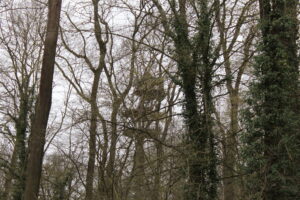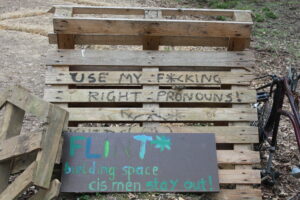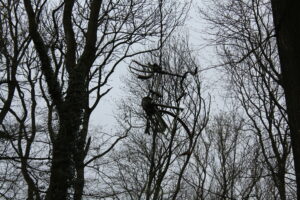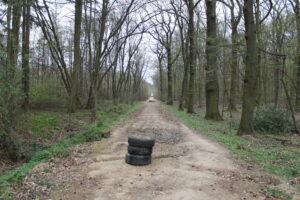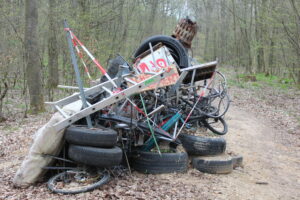Table of Contents
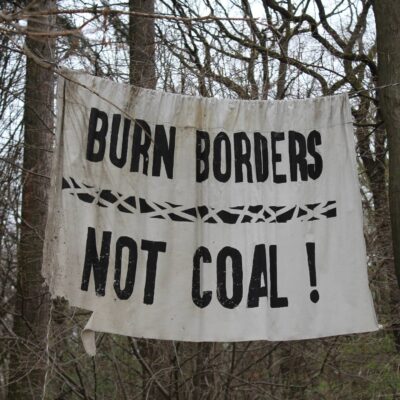
Hambach Forest: Data and Facts
Name: Bürgewald, also known as Hambach Forest or Hambi
First occupation: April 2012 – November 2012
Second occupation: September 2013 – March 2014
Since 2015, alongside the ongoing occupation in treehouses and tents, there have been repeated actions against RWE.
Good to know
The Hambach Forest is the remaining part of the Hambach Woods, which covered around 4,100 hectares in the 1970s. Since the first RWE excavator began lignite mining between Aachen and Cologne on October 15, 1978, this forest area has shrunk to a remnant of around 200 hectares.
Hambach Forest: Information about the Bürgewald in Garzweiler
The Hambach Forest, a woodland area near Garzweiler in the Rhineland, has drawn a lot of attention in recent years. The forest is known for its intense protests against lignite mining and the associated deforestation. The confrontations between activists and the police have often led to violent conflicts.
In the Hambach Forest, there are numerous treehouses and barricades built by activists to prevent the forest from being cleared. The forest occupations continue to this day and have become a symbol of resistance against the destruction of nature and climate change.
The Hambach Forest has become a significant site of environmental activism in Germany. The protests have helped raise awareness about the importance of environmental protection and sustainability. People in Germany and around the world follow developments in the Hambach Forest with great interest.
Although the Hambach Forest remains a contested area, there are also positive developments. Efforts are being made to protect and preserve the forest to maintain its significance for the environment and climate. The Hambach Forest continues to be an important symbol for environmental protection and the fight against the climate crisis.
Arrival at the Hambach Forest parking lot
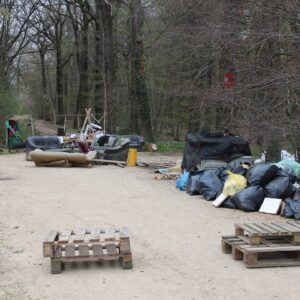
Trash collection point of the environmental activists from the open-pit mine at Bürgewald Hambach
The Hambach Forest near Garzweiler in the Rhineland is known for its years-long conflict between environmentalists and the energy company RWE, which wants to mine lignite there. For many years, the forest has been occupied by activists who are fighting against deforestation and for the preservation of the forest. When I visited the forest in 2021, I was surprised by the situation at the parking lot.
The parking lot was accessible only for small vehicles due to a barricade. This was likely a measure by the forest occupiers to block access for larger vehicles, especially those of RWE. I parked my car in the lot and walked to the entrance of the Hambach Forest.
As I made my way to the entrance, it became clear that I was in a place with a very charged atmosphere. I saw many posters and signs addressing the conflict between the environmentalists and RWE. The heap of trash in front of the Hambach Forest was also a sign of the confrontations. The forest occupiers had set up a collection point there where they had deposited the trash they had gathered in the forest. A sign asked visitors to dispose of the trash and thus support the environmentalists.
I was curious about what to expect in the forest and whether I would encounter activists or RWE employees.
As I continued towards the entrance of the Hambach Forest, I could see a campsite with various tents, sleeping bags, and other equipment. There, I also found a memorial established by the environmentalists to honor the individuals who had died during the conflicts related to the forest clearing. A masked activist standing nearby later told me that this was a memorial site where activists are trying to pay their respects to the deceased while also drawing attention to their cause. It was a moving experience to see the memorial and hear the stories behind the people who lost their lives in this struggle. It also illustrates how committed the environmentalists are to defending their stance and the importance of preserving the Hambach Forest.
I noticed some graffiti slogans that were critical of the police. These were located near the memorial. Some of the slogans were very provocative and offensive, seemingly aimed at escalating the conflicts between the activists and the police.
However, it is important to note that the conflict in the Hambach Forest between the activists and the police is very complex and dates back many years. The activists have fought for years to preserve the forest, claiming that its clearing for lignite mining in Garzweiler poses a serious threat to the environment.
The negative slogans against the police at the campsite show how deeply rooted the conflict in the Hambach Forest is and how difficult it is to find a solution that is acceptable to all parties involved. However, it is important that discussions and negotiations between the activists, authorities, and other stakeholders continue in order to find a sustainable and responsible solution for the preservation of the Hambach Forest.
Treehouses of the forest and the environmentalists
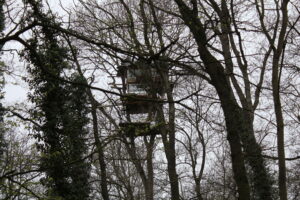
A part of a treehouse in Bürgewald from the protests
I was surprised by the creativity and dedication of these people who are so passionately committed to protecting the forest.
As I continued towards the open-pit mine, I saw more and more treehouses and huts built by the activists on both sides of the path.
Some were simple, while others were artistically designed and looked almost like treehouses from a fairy tale.
I frequently encountered activists who greeted me warmly and gave me flyers or informational materials about the history of the Hambach Forest.
I was impressed by their passion and their knowledge of the subject.
Finally, I reached the edge of the open-pit mine and looked out over a vast landscape dominated by RWE’s excavators and conveyor belts.
I felt both sad and angry and understood why the activists are fighting so hard to protect this beautiful forest.
Barricades and obstacles against the clearing of Bürgewald
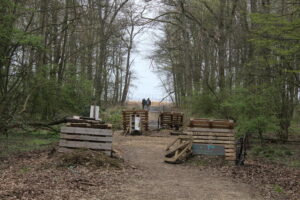
Compact and large barricades for the protests against the eviction dispute
The obstacles and barricades are a common tactic used by the forest occupiers to make it more difficult for the police to access the area and to prevent their presence in the forest. These are usually self-built structures made from wood, wire, and other materials, placed on the ground or in the air.
The activists argue that the obstacles are necessary to ensure their safety and to prevent the police from clearing the forest. However, there is also criticism of this tactic, as it not only complicates the work of the police but can also hinder emergency response efforts.
Some activists have therefore incorporated or marked escape routes in the barricades to enable quick evacuation in case of emergency. Nevertheless, the issue of safety in the Hambach Forest remains a contentious topic and continually sparks heated debates between the forest occupiers, the police, and other stakeholders.
The path from the forest to the RWE lignite open-pit mine
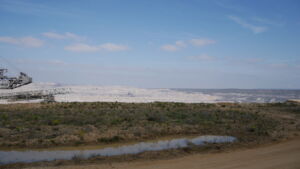
A picture of the RWE lignite open-pit mine in Hambach – Is this what sustainability looks like?
As I continued through the forest, I noticed how alive it was despite the presence of the activists. Everywhere I heard birdsong and the rustling of animals in the underbrush. I saw squirrels, rabbits, and deer making their way through the forest undisturbed by humans.
I was also very impressed by the treehouses built by the activists. I could see how much work and creativity had gone into each one. Some were even multi-story and connected by bridges and ropes.
I spoke with some of the activists, and they told me about their lives in the Hambach Forest. They were very dedicated and passionate in their fight against the lignite mining and the resulting destruction of the forest.
I could also feel that there was a strong sense of community among the activists. They worked together to maintain the barricades and support each other.
As I finally left the forest, I felt inspired by the determination and passion of the activists. I was certain that their fight to protect the forest and nature was far from over.
Conclusion on the Hambach Forest, RWE, and the clearing
After Spiegel and other magazines reported on the work of the coal commission, the planned phase-out, the clearing of the Hambach Forest, and the associated demonstrations, I set myself the goal of personally visiting Bürgewald, or Hambach Forest, over the weekend. My aim was to get a firsthand impression of the situation, experience the clearing process, and understand the sustainability of the conflict.
